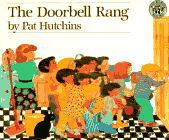Carol Hurst's Children's Literature Newsletter
Volume 1, Number 2. July 1996. Page 4.
![]()
You can sign-up to have this newsletter sent automatically to your email address every quarter.
![]()
Featured Author
Pat Hutchins
Let's take a look at Pat Hutchins and her work. She was born in England in 1942, one of seven children. She loved drawing from the time she was very young and was given a scholarship to art school when she was sixteen. At first her art work was confined to the field of commercial art in London, but after she was married, she lived in New York for a while. There she showed her work to some publishers and the very successful Rosie's Walk was the result. Since that time she has published many books which have met with success on both sides of the Atlantic.
Some of the books are:
Changes, Changes. Macmillan, 1987 ISBN 0-689-71137-9.
In this wordless book, dolls cope with every emergency by using blocks imaginatively.
Clocks and More Clocks. Macmillan, 1994 ISBN 0-689-71769-5.
Mr. Higgins finds a beautiful clock in the attic and starts it going but doesn't know what time to set it to so he buys another clock which he puts in the bedroom. The two clocks don't agree so he buys a third and so on. Eventually, a watch solves his problem.
Don't Forget the Bacon. Morrow, 1989 ISBN 0-688-08743-4.
A child is sent by his mother with a short mental list of things he must get. Each thing he sees on the way, however, transforms the list. What he buys at the store is nothing like what he starts with. On the way home he transforms the list to its original state, but he forgets the bacon.

The Doorbell Rang. Morrow, 1989 ISBN 0-688-09234-9.
Ma has made a big plate of cookies and the two children are just about to share them when the doorbell rings. Each ring of the doorbell brings more people who must share those cookies.
Good Night, Owl. Macmillan, 1990 ISBN 0-689-71371-1.
Owl has a hard time sleeping because it's daytime and the forest is full of the sounds of the diurnal animals. When nighttime comes, it's a different story and Owl gets his revenge.
One Hunter. Morrow, 1986 ISBN 0-688-06522-8.
This is Hutchins' counting book and the hunter looks throughout the forest seeing not a single animal, but we do.
Rats. Greenwillow, 1989 ISBN 0-688-0776-5.
In this slightly longer book, Sam badly wants a rat for a pet. His mother refuses until Sam gets a knock on the head. Although it doesn't really hurt him, he gets enough sympathy from his mother to get the rat. Although Sam loves Nibbles, others are not so sure.
Rosie's Walk. Macmillan, 1971 ISBN 0-02-043750-1.
Rosie the hen takes a leisurely walk around the barnyard oblivious to the fox who is constantly being foiled in his attempts to get Rosie.
The Surprise Party. Macmillan, 1986 ISBN 0-02-745930-6.
The invitation to the party starts out all right, but it gets mangled as it transfers from person to person.
Titch. Aladdin, 1992 ISBN 0-689-71688-5.
Titch gets his revenge over his older brother and sister.
The Very Worst Monster. Morrow, 1989 ISBN 0-688-09038-9.
Hazel is not thrilled with the attention newborn Billy Monster is getting. Eventually she gives him away earning her parents' attention and the title of "very worst monster".
What Game Shall We Play. Greenwillow, 1990 ISBN 0-688-09196-2.
The animals are searching for each other in order to find a good game to play. They find each other and end up playing a game of hide and seek which, really, they've already been playing.
Which Witch is Which? Greenwillow, 1989 ISBN 0-688-06358-6.
When twins choose twin witch costumes, it's hard to figure out which witch is which twin, but there are clues in the text to follow.
The Wind Blew. Penguin, 1974 ISBN 0-14-050236-X.
The wind does indeed blow and it snatches something from almost everyone we see. Each chases their possessions and the chain of chasers gets longer as they approach the city. When the wind drops their things, they are all mixed up.
Many of her books have a strong pattern in the illustrations as well as in the text and, therefore, make strong books for the math program connection. Visually her picture books seem to fall into two categories: some are done with a pastel palette and have intricate line patterns. What Game Shall We Play, One Hunter and Don't Forget the Bacon seem to fit that category. Other books such as The Doorbell Rang seem bolder, less intricate with wide characters, brighter colors and less detail. Students might like categorizing the books according to this or other visual clues. Several of her books are about the same characters, Titch and Billy for example and can be viewed as series of books.
While the pattern in the text of her books is often obvious, it never overpowers the story and so with a book by Pat Hutchins in hand, you usually can find a willing audience.
![]()
For your convenience you can order these books directly from an online bookstore (Amazon.com):
- Order Pat Hutchins' Books.
Here's more information about our direct order service.
![]()
Go to Next Section of Newsletter, Featured Subject.
Back to Previous Section of Newsletter, Professional Book Review
Return to First Page of Newsletter
Advertisement:
Advertisement:
Advertisement:

